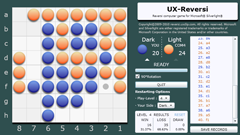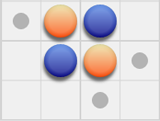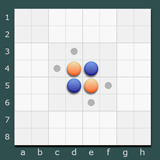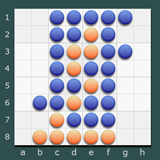Statistics (Total results of gameplays : All Users v.s. Computer)
UX-Reversi

UX-Reversi is a simple computer reversi abstract strategy game designed for Microsoft® Silverlight®. This game features an original compact artificial intelligence engine, that allows you to enjoy exciting game-plays, as if you were playing reversi versus a real human opponent.
* Microsoft and Silverlight are either registered trademarks or trademarks of Microsoft Corporation in the United States and/or other countries.
How-to-Play Instructions



Gameplay controls: The game can be played only with mouse actions —— clicking on a blinking square to put a piece there in your turn. When you can't make a move, a balloon popups to notify you, and play-turn automatically switches back to the computer player.
Beginning a new game: You can play a new game anytime by clicking "QUIT/RESTART" button. Prior to restarting a game, select a play-level and your side (Dark[plays first] or Light[plays last]) from drop down menus.
Results: Your gameplay results (numbers of wins, losses and draws in each level) are persistently stored in local isolated storage and are displayed in brief statistical report form that enables you to grasp your overall achievements.
* All play-results on this game are sent to the server automatically upon every end of your gameplay. The collected data is to be used for statistical purposes required for future updates of the game. Through this practice, personally identifiable information about you shall not be collected.
Rules of reversi

Reversi is a traditional abstract strategy board-game played by two players. Players put double-side-colored (dark/light) disc-shaped pieces with own side face up in alternating turns onto a board consists of 8x8 squares to have majority on the board. Players can put a piece only in valid vacant positions in which the newly put piece and another existing own piece form a straight (horizontal/vertical or diagonal) occupied line with at least one or more contiguous opponent's pieces sandwiched between them. All the opponent's pieces caught on the line (between the new piece and any anchoring pieces on the board) are reversed to turn to own pieces. When one player cannot make a valid move, play-turn passes back to the other player and the game continues. When neither player can play, the game ends and the winner is determined according to the number of pieces on the board.
Frequently Asked Questions
*If you have questions to be put here, please write an email to the contact address through "feedback" link in the footer of this web-page.
Appendix A: ABC's of Reversi Strategy - How to Win
Control over corners: Once a piece is put on one of the four board-corners (a1, a8, h1 or h8), that piece will never be flipped throughout the game. This means a corner-piece directly brings you definitive score gain. And also, a piece on the corner works effectively as an anchor for edge-occupations that leads to wider area occupation over the board. Anyway, to put your piece on a corner, tactically let the opponent put a piece on one of neighboring squares (such as a2, b1 or b2 for a1 corner). And, by contraries, special care must be taken when you put a piece on such highly risky squares so that the corner won't be occupied by a opponent piece easily.

Avoid shortage of available moves: For keeping on making good moves throughout the game to win, it's important to avoid shortages of choice of moves. Number of available moves primarily depends on the number of anchoring pieces available on the board. Try to choose moves so that your pieces will remain in inner part of cluster of pieces on the board to make them work as good anchoring pieces for following sequence of moves. Well-distributed anchoring pieces will allow you to take advantages of a lot of available moves later, and that may lead you to win.
Appendix B: The Character of the Reversi Artificial Intelligence(AI) Engine
In designing the AI engine of this game, decision making process of a standard human player is quantitatively modeled. Thus, the AI engine basically behaves like a human opponent, and sometimes takes rather high risks to win game in a dramatic way. This unique feature may bring you exciting versus-cpu-reversi gameplays that you've never experienced with other serious reversi programs nowadays.
| Reversi AI of this game | Conventional Reversi AI | |
|---|---|---|
| Risk Management | Take risks to win dramatically. | Minimize risks to win safely. |
| Methodology | Evaluate current localized environment to decide good position to put a piece. | Deeply search all possible moves or refer to predefined database to find the perfect move. |
| Play Skill Level | Beginner - Intermediate. | Intermediate - Expert |
More Resources : 3D MAZE | 3D DOGFIGHT | 3D CAR-DRIVING | REVERSI | CHESS | NUMBER PLACE | 3D TENNIS | WARGAME